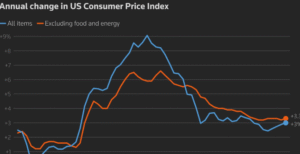$WTI $BRENT $XOM
#OilPrices #CrudeOil #WTI #BrentCrude #OPEC #RussiaUkraine #Trump #Putin #Zelensky #EnergyMarkets #Geopolitics #Commodities
Oil prices continued their downward slide on Wednesday following reports that former U.S. President Donald Trump personally reached out to both Russian President Vladimir Putin and Ukrainian President Volodymyr Zelensky in an effort to push for a negotiated solution to the ongoing war. Market sentiment, already under pressure from a strong U.S. dollar and concerns about weakening global demand, turned more bearish amid speculation that Trump’s involvement could accelerate diplomatic efforts and pave the way for a resolution. In early Asian trading on Thursday, Brent crude futures for April delivery dropped 0.9%, settling at $74.48 per barrel, while West Texas Intermediate (WTI) crude for March delivery fell to $70.70 per barrel, reflecting a broader decline in energy commodities. Traders reacted swiftly to Trump’s announcement on social media, where he claimed he and Putin had agreed to initiate formal negotiations, fueling expectations that a possible ceasefire or peace talks could ease geopolitical risk premiums embedded in oil prices.
A potential breakthrough in the Russia-Ukraine conflict would have profound implications for global energy markets. Russia, a leading crude oil and natural gas producer, has faced sweeping Western sanctions limiting its exports and restricting its access to financial markets. If diplomatic efforts gather momentum, markets could see an increase in Russian oil supply, narrowing the existing supply constraints imposed by the European embargoes and price caps. Additionally, a de-escalation in hostilities would likely reduce the urgency for Western nations to sustain high strategic petroleum reserves, relieving some pressure on crude benchmarks. At the same time, markets are grappling with concerns over slower economic growth in major oil-consuming nations, particularly China and Europe, which could offset supply-side risks and further weigh on prices. The confluence of these factors has led analysts to speculate that if geopolitical tensions ease significantly, Brent crude could potentially test support levels near the $70 mark, while WTI could slip into the high $60 range.
Beyond the immediate price reaction, the broader energy market is also assessing the potential repercussions for oil-producing nations and large energy corporations. Shares of U.S. oil majors such as ExxonMobil ($XOM), Chevron, and European counterparts like BP and Shell have seen increased volatility as investors reposition their portfolios. A prolonged drop in crude prices could squeeze profit margins for these companies, particularly those heavily invested in upstream operations. Moreover, the Organization of the Petroleum Exporting Countries (OPEC) and its allies, including Russia (OPEC+), may come under renewed pressure to reassess their production strategy. OPEC+ had previously implemented output cuts to defend prices, and any signs of increasing supply from Russia could strain relations within the group. If crude prices continue trending lower, investors will likely watch for signals from Saudi Arabia and other key producers regarding possible policy adjustments to stabilize the market.
The oil market remains highly sensitive to geopolitical developments, and traders will closely monitor any further statements from Trump, Putin, or Zelensky regarding ceasefire negotiations. While Trump’s initiative could be welcomed by markets as a step toward conflict resolution, significant uncertainties remain regarding the feasibility and timeline of any peace deal. Additionally, the U.S. Federal Reserve’s stance on monetary policy—including interest rate decisions—will continue to influence global commodities, as a stronger dollar makes oil more expensive for international buyers. In the near term, price volatility is expected to persist as markets weigh the balance between diplomatic progress, supply dynamics, and broader economic factors. For now, traders remain cautious, bracing for swift moves in response to any fresh geopolitical or macroeconomic developments.










Comments are closed.